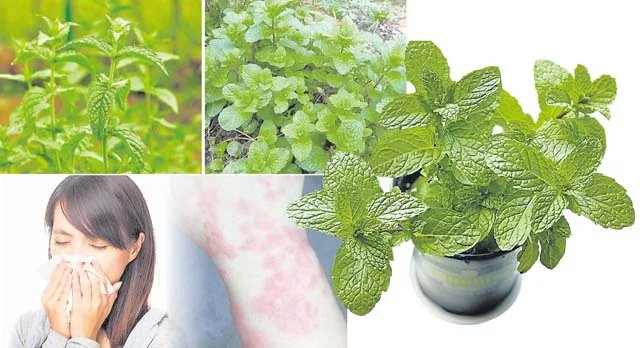When people feel tired, applying a bit of cooling ointment on the forehead or having a piece of mint candy often makes them feel refreshed. Why is this? Because mint primarily contains menthol, menthone, and rosmarinic acid, which can stimulate the brain, reduce inflammation, relieve pain, and disperse wind and heat. Mint can be used as a fragrant seasoning in dishes, such as mint porridge, mint tea, mint cake, or mint liquor, and it can also be used in salads. Mint is also a traditional Chinese medicine. If a person experiences nasal congestion, fever, and discomfort in the throat due to a cold-induced upper respiratory infection, mint can be used for treatment. Additionally, it has the effects of dispelling wind and relieving itching.
Main Character: Mint
Properties: Spicy, cool; it belongs to the Lung and Liver meridians.
Functions: Disperses wind-heat, clears the head and eyes, benefits the throat, and promotes smooth flow of liver qi.
Contraindications: People with yin deficiency, blood dryness, or those with exterior deficiency should use mint with caution.
In the past two years, due to the impact of the coronavirus, people’s desire for health and their pursuit of naturally effective food from nature have led to the increasing recognition and acceptance of traditional Chinese medicine’s philosophy of “food and medicine share the same origin, and food therapy comes first.”
Dr. Wong Si Yan of Pujian Traditional Chinese Medicine Clinic explains that mint is a great example of this concept. Mint leaves can be consumed fresh or dried for medicinal use.
Additionally, the unique cooling and fragrant properties of mint are widely used in modern pharmaceuticals, food, cosmetics, and fragrance industries. Fresh mint contains proteins, fats, carbohydrates, dietary fiber, and various vitamins, making it a nutritious and therapeutic food. It can be used as a seasoning, made into tea, porridge, soups, and even used in cooking.
“Dry mint is a traditional Chinese medicine. According to TCM theory, mint is spicy and cool and belongs to the Lung and Liver meridians. While mint is a food and medicine dual-purpose item, its spicy and cool nature makes it unsuitable for everyone. People with yin deficiency, blood dryness, excessive sweating, or exterior deficiency should use mint with caution. Those with spleen and stomach deficiency, cold, diarrhea, and loose stools should also avoid consuming mint excessively or for long periods.”
Relieving Bronchitis and Colds
Dr. Wong Si Yan continues to explain that in traditional Chinese medicine, compound prescriptions are composed of single or multiple herbs combined under the guidance of TCM theory. Most Chinese herbs perform different functions in different compound prescriptions and are used to treat various clinical conditions.
“Mint is one of the most commonly used herbs in the treatment of wind-heat in TCM. It has a certain sweating effect and is used for dispersing wind-heat. It is often combined with honeysuckle, burdock seed, platycodon, and schizonepeta to treat wind-heat colds, such as in the well-known Yin Qiao San and Sang Ju Yin formulas. These formulas are used to treat wind-heat colds. In ‘Wen Bing Tiao Bian,’ there is a record of Sang Ju Yin, which is primarily used to relieve bronchitis, upper respiratory infections, and cold symptoms. Mint in these prescriptions is used for its effect of sweating and dispersing wind-heat.”
In addition, mint has the characteristic of being aromatic and lifting, helping to clear wind-heat from the head and eyes, and benefiting the throat. In clinical practice, mint is often combined with drugs like Siler, platycodon, licorice, and chrysanthemum to treat symptoms such as headaches, dizziness, and sore throat.
“Mint also has the ability to dispel rashes and relieve itching. It is often combined with cicada slough and burdock seed in formulas such as Bamboo Leaf and Willow Burdock Soup. This formula is recorded in the ‘Xian Xing Zhai Yi Xue Guang Bi Ji’ and has been shown to be effective in treating early measles or wind rashes and itching. Modern research shows that menthol, the main active ingredient in mint, has significant anti-itch and anti-inflammatory effects.”
Treating Liver Qi Stagnation
In TCM, negative emotions or stress can affect the liver’s ability to regulate the flow of Qi in the body. When the Qi is obstructed, it leads to stagnation, which can cause emotional distress and slow down the gastrointestinal movements, resulting in reduced appetite.
Mint enters the Liver meridian and, due to its aromatic nature, promotes the liver’s function of dispersing Qi, thus regulating emotions and treating liver Qi stagnation, which can lead to feelings of frustration and anxiety. The Song Dynasty’s ‘Taiping Heji Ju Fang’ also records a formula containing mint, Xiao Yao San, which can smooth the liver, relieve stress, and is commonly used in clinical practice to improve symptoms like headaches, dizziness, fatigue, and loss of appetite caused by Qi stagnation.
“Mint is easy to obtain and cultivate. You can place a mint potted plant on your desk. Its fresh green leaves and aromatic scent are not only pleasant but can also be brewed into tea. It is very suitable for modern people with fast-paced and busy lives. With the high levels of stress in modern society and the crowded environments of big cities, emotional issues are very common, especially during the pandemic. The pressure from work and life changes directly affects emotional health, leading to feelings of depression, anxiety, and irritability. Using mint can help relieve these issues. I recommend two recipes for daily health care and comfort: mint porridge and water chestnut mint drink. However, if the discomfort persists, it’s essential to seek medical attention.”

